

  |
|
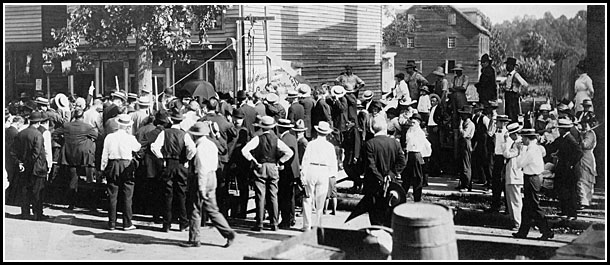
|
Name: Laying the Masonic Lodge Cornerstone, 1914 Date: June 17, 1914 Image Number: B421cdB28 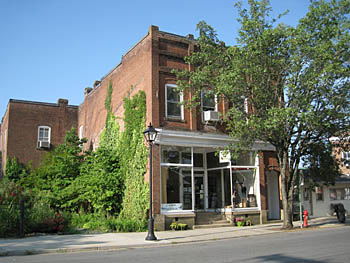
Comments: On June 17, 1914, Scottsville Masonic Lodge #45 laid the cornerstone for its current home at 137 Main Street. It was a stirring day in Scottsville with the town band marching down Valley Street, leading Lodge members from their meeting area at Beal's Hall to the new Lodge site. The first Lodge meeting was held in the upstairs meeting area after the building was completed in 1915 at a cost of $6000. The United States Government rented the building's first floor to serve as the Scottsville Post Office from 1915 until the post office moved in 1964 to a new location on West Main Street. In 2010, Coleman's Outdoors store occupied the old Post Office's first floor. Masonic Lodge #45 began its history in Scottsville on December 7, 1851 and received its charter at their Valley Street meeting hall on the second floor of the Beal Building. James W. Mason opened and closed the charter night exercises as the first Worshipful Master. Members present for this historic meeting were William B. Brady, Sr.; John Hickok, Jr.; James Brady; Silas W. Dawson; Charles E. Little; J.L. Brady; J. M. Wade; W. F. Crawford; James A. Forbes; J.B. Dodd; W. Donoho; and James A. Leitch. On December 7, 1951, the Scottsville Masons celebrated their 100th anniversary with a public ceremony in front of the Scottsville Masonic Lodge. Following the public program, a social hour was held in the Banquet Room of the Lodge for the members and visiting masons. At 6:30 pm, a banquet was held in the Auditorium of the Scottsville High School which was also ladies night; the guest speaker was Past Grand Master of Masons in Virginia and then the current Grand Secretary of the Grand Lodge of Virginia. The Scottsville centennial committee in charge of the arrangements for their 100th anniversary celebration was composed of Rt. Wor. A.R. Thacker, Chairman; Wor. W. A. and Ellis P. Jones. The History Committee was composed of Rt. Wor. F.P. Scott; Chairman Rt. Wor. J.H. Duncan; Wor. C.A. Whitted, John P. Dorrier, and T.H. Gillis. In honor of this Masonic anniversary, the History Committee authored a history of the lodge which was printed for distribution on December 7 and found records complete through the Civil War years. On the roster of members of Scottsville No. 45 were Peyton S. Coles, Grand Master of the Grand Lodge of Virginia in 1879 and 1880. There were also three Past District Deputy Grand Masters of the 17th Masonic District who were members of Lodge 45: J.H. Duncan, A.R. Thacker, and F. Pierson Scott. In 1951 the officers of Lodge 45 were E.B. McCormick, Wor. Master; L. E. Baber, Senior Warden; Larkin Londeree, Junior Warden; J.W. Boggs, Senior Deacon; T.H. Gillis, Junior Deacon; T.A. Allison, Chaplain; C.R. Dorrier, Treasurer; C.A. Whitted Secretary; A.L. Thacker, Tiler; and J.E. Daniel, Chaplain emeritus. History of Scottsville Lodge #45, AF&AM GRANTING OF CHARTER The Scottsville Lodge, No. 45, A.F. & A.M., received its charter from James Evans, Grand Master of Masons in the State of Virginia on December 7, 1851. Lodge meetings were held in Scottsville prior to the year of 1851. It is impossible to determine when the first meetings were held since no minutes or records were kept. It is known, however, that a group of men in and around Scottsville formed themselves into a lodge and elected James A. Leitch as their Worshipful Master. It was through his efforts that the Grand Lodge of Virginia was petitioned in order to secure a charter for the Scottsville Lodge. At this time, James Evans was Grand Master of Masons in the state, and it became his duty to examine the petition. After due investigations and with the consent of the Grand Lodge, he constituted and appointed on trusty the following brethren: James W. Mason, Master William B. Brady, Senior Warden John Hickok, Junior Warden These men along with those, who were admitted to work with them, were constituted into a lodge of Ancient, Free, and Accepted Masons by the name, title, and designation of Scottsville Lodge, No. 45. With this granting of charter, the lodge received full power to receive and enter apprentices, to pass fellow crafts, to raise Master Masons, and to perform all other works of the craft according to the ordinances and regulations of the Grand Lodge of Virginia. The Lodge was also instructed to regulate its own dues, adopt and record its own bylaws, and keep an accurate record of the minutes of all meetings. The full account of the granting of the charter for the Scottsville Lodge can be found in Volume No. 1, of the Minutes, as recorded by John Dove, Secretary of the Grand Lodge of Virginia. LOCATIONS As Scottsville Lodge, No. 45, A.F. & A.M., marks its hundredth anniversary on December 7, 1951, the brotherhood can view with pride the accomplishment of having moved locations only three times over the century. The accomplishment is even greater with the century recalled. It was one hundred years fraught with wars and depressions, and yet Scottsville Lodge has lived and prospered. The fascinating story opens on December 7, 1851, in Beal's Hall, located in the center of Scottsville. The site today is the floor above Mathias' Store on Valley Street and State Route 20. Here the Lodge met for instruction, work, and refreshment for twenty-nine years, and here the Lodge received its charter. Charter night was an inspiring meeting. James W. Mason opened and closed the charter night exercises as the first Worshipful Master. The records record that William B. Brady, Sr., was the Senior Warden, and John Hickok, Jr., was the Junior Warden. Members present for the historic meeting were: James Brady, Silas W. Dawson, Charles E. Little, J. L. Brady, J. M. Wade, W. F. Crawford, James A. Forbes, J. B. Dodd, W. Donoho, and Right Worshipful James A. Leitch. Twenty-nine years later in 1880, the Lodge bought the upstairs floor of the present home of Mrs. John Mayo, of Scottsville, Virginia, and paid $229 for it. This move was unique in the annals of Virginia Masonry. Not many lodges have purchased only one floor of a building for a meeting place and that property a part of a private home. This arrangement held for fifteen years. In 1895, the Lodge bought the first floor for $300, and rented it to Dr. Anderson, D.D.S., from 1895 to 1913. The second move came in 1913 when the Lodge sold the entire building to Dr. L. R. Stinson, of Scottsville, Virginia, for $1,250, and transferred back to Beal's Hall, the birthplace of the Lodge. This was the home of the Lodge until January 1, 1915. The first meeting in the new Lodge Hall was not held until January 29, 1915. During the occupancy of Beal's Hall, the Lodge paid a rent of $21 for a six-month period with the exception of June, 1914, to December, 1914, when the average rent was $20 for the six-months' period. June 17, 1914, was a red-letter day in the life of the Lodge. On that date, the cornerstone was laid for a new building, and the present home of the fraternity. On the minutes of the Lodge is written, "The Worshipful Master informed the brethren that this special communication had been called for the purpose of laying the cornerstone in the erection of a Masonic Hall on Main Street of Scottsville, Albemarle County, Virginia. Right Worshipful H. G. Harris was called to preside in the East and filled the offices pro-tem as follows: Wor. T.E. Bruce, Sr., Warden; Wor. L. G. White, Junior Warden; S. R. Gault, Treasurer; T. M. Staples, Secretary; T. F. Robinson, Senior Deacon; Worshipful L. R. Stinson, Junior Deacon; L. H. Walton, Chaplain, and R. L Blackburn, Marshal." It was a stirring day in Scottsville. The Lodge led by the Scottsville Band marched down the street to the site of the new building on Main Street. The cornerstone was laid in due and ancient form. Again the line of march was formed, and the brothers paraded behind the band to Moore's Hall. Here John B. Moon, a Past Master of Scottsville Lodge, was presented, and he in turn introduced Most Worshipful Brother R. T. W. Duke, Past Grand Master of Masons of the State of Virginia. The orator gave a forceful address. Following the address, the brothers marched back to Beal's Hall. Due thanks were given to Brother Duke and the Scottsville Band. Seven months later on January 29, 1915, the Lodge met at its third and present location. It was a new, two-story brick building and had been constructed at the cost of $6,000. The contractors for the new hall were Paulett and Grove. The lower floor of the Masonic building was rented to the United States government for use as a Post Office. It is interesting to note that today there are four pieces of the original furniture still on hand in the Lodge. The Altar is the only one of the three pieces still in use at this time. New furniture for the station officers was purchased by the Lodge. That is the record. It is indeed a stable one and gives assurance that the Lodge will live on into a bright future. As we pass along through this sometimes difficult life, we find that a little humor spread along here and there will often help make the pathway a little more easy to tread and apparently some members of our Lodge thought the same thing a generation ago. In the Town of Scottsville, a few years following the Civil War, there were two newspapers printed. One was known as the "James River Clarion," and the other one was the "Scottsville Courier." These two papers were printed by two brethren who were members of the Scottsville Masonic Lodge, No. 45. One was Major James C. Hill, and the other was Mr. William B. Brady. Major Hill was a devout Christian gentleman while Mr. Brady, being all the same a gentleman, did very frequently use the wine cup, and it was not infrequent that he was seen on the streets of our town under such influence. At that time, there was only one printing press in Scottsville so it was that Mr. Hill would print his paper one week, and then Mr. Brady would print his paper the following week, and so on... Having seen Mr. Brady slightly under the influence one morning just before printing his paper, Mr. Hill thought that he would have some fun at the expense of Mr. Brady by printing a little poem. No sooner said than done. Major Hill printed the following article in his paper: Between Brady and brandy There is the difference of a letter When Brady is full of brandy Times seem to be better. No sooner than Major Hill's paper reached the street, someone had taken a copy to Mr. Brady, whereupon the gentleman literally hit the ceiling. The following week when Mr. Brady printed his paper, he came back with a reply to Major Hill thus: Between Hill and hell There is the difference of a letter When Hill is in HELL Times will be better. A Building That's Seen A Lot! by Ron Smith One of the great things about Scottsville is its obvious history. And, as visual testaments to that history are the town's historic buildings. Glancing around one can easily imagine some historical figure with which they are familiar strolling past or into one of these structures. The Scottsville Museum's annual Spirit Walk has provided many local residents with the opportunity to associate names that are familiar with buildings they might pass daily. The Masonic building on East Main Street is one of these buildings. Home to Scottsville Masonic Lodge No. 45 for more than one hundred years, this building has seen a lot! During the late 1800's and early 1900's Scottsville's Beal Building on the corner of Valley Street and Bird Street was "the place" to hold events, meetings or any other reason to gather a significant number of persons together in one place for a specific cause. A fundraising dance was held there in 1902 to raise money to start the first "real" library in Scottsville. Masonic Lodge No. 45, with its long and rich history, was chartered by the Grand Lodge of Virginia on December 17, 1851. Members met in a room on the second floor of the Beal Building until 1880 when they relocated to the upstairs of a private residence on Valley Street. In a 2005 article by writer Ruth Klippstein, former Scottsville Mayor Raymon Thacker remembered "his family first lived on the first floor of this home after moving to Scottsville and before they moved into their own home." The Masonic lodge actually bought the second floor of this house and then the whole house! Dr. Luther Randolph Stinson would come to own the home. Wishing to have a building of their own, like other lodges around the country, the lodge decided to take the necessary steps to make that dream a reality. In 1914 Lodge No. 45 purchased a parcel of land on Main Street. Some records indicate the property was purchased from the town while Mayor Thacker remembered it being purchased from the county. Either way the town would soon benefit from a beautiful new building that would stand firm and tall and weather the forces of nature that would attack her in the years to come. 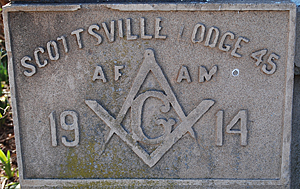 Regardless from whom the purchase was made, and with a deed dated October 14th, 1914, Lodge No. 45 now had their own tract of land.
The purchase price was $250, and with a $4000 loan from the town, the lodge was on its way to having its own permanent meeting place.
Regardless from whom the purchase was made, and with a deed dated October 14th, 1914, Lodge No. 45 now had their own tract of land.
The purchase price was $250, and with a $4000 loan from the town, the lodge was on its way to having its own permanent meeting place. On June 17th, 1914, following a parade, and with speeches by visiting Masonic dignitaries and the presence of a large number of town residents, the cornerstone (shown at right) was laid and the Masonic Building we know today was, like an expected baby, about to be born into this world and the history of Scottsville. 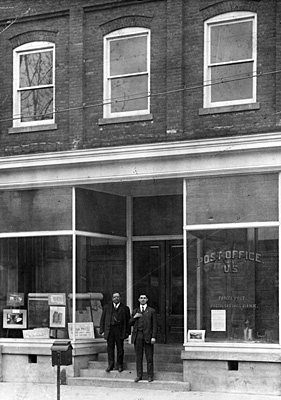 A Scottsville firm, Paulett and Grove, two names found in much of Scottsville's history, was chosen as the general contractor. The new
two-story building had a suitable space for a business of some type on the first floor, while the upstairs would be the primary home of the
Masonic Lodge. A Scottsville firm, Paulett and Grove, two names found in much of Scottsville's history, was chosen as the general contractor. The new
two-story building had a suitable space for a business of some type on the first floor, while the upstairs would be the primary home of the
Masonic Lodge.Scottsville's postmaster, Sam Gault, was a member of the lodge. The post office was housed in a storefront on Valley Street and needed a larger space as the town continued to grow. Gault suggested the post office be relocated to the first floor of the new building. The post office moved to its new location and remained there until 1964. (Shown at left Postmaster Samuel Gault and Ashby Mayo at the Scottsville Post office in 1915) Rent generated from the post office was used by the lodge to help with building maintenance, "not for a profit" as Mayor Thacker remarked. While no one seems to remember who the architect for the project was, many think it may have been D. Wiley Anderson who designed Victory Hall. He had relocated from Richmond back to Scottsville during the time frame that could have made him the obvious choice. The National Register of Historic Places identifies the building as "Modified Edwardian," and at the time of Klippstein's 2005 article, local architect Fred Schneider and Architectural Review Board Chairman Jeffrey Plank "suggested that 'modern commercial' might better describe a business, rather than a domestic structure." With its dark red bricks, the placement of windows, the white trim and flat roof, the building is similar to several other Masonic Lodge buildings that can be found around the country. Another feature of the building is the metal ceilings. A number of buildings in Scottsville have the metal tile ceilings which became popular around 1885. The plaster work found in European buildings was attractive to people in this country. When these metal tiles came upon the scene. it offered builders an opportunity to install ceilings that looked like their European counterparts but were easier and less expensive to have. The Masonic Building incorporated this type of ceiling on each floor and those ceilings remain in place today. The metal ceilings give another hint as to Anderson being the architect as he was, from his work in Richmond, very knowledgeable on the subject of metal ceilings. Sam Gault was a dedicated postmaster for Scottsville and actually lived in the post office! He occupied an apartment in the rear of the building. He also found it necessary to make some changes, one of which involved the post office safe. You don't see many businesses today that have a big bulky safe prominently in view of the public although some do exist. Like most safes of the day the safe was heavy enough to begin with, but add the contents and see what happens. The post office safe was too heavy for the floor on which it sat so Gault had an extra concrete pad made on which the safe could rest. When Gault passed away in 1939, Mayor Thacker was asked to look for Gault's insurance policy. He found it in the apartment, and Gault's final expenses were taken care of. Gault rests in the Scottsville Cemetery with an appropriate memorial depicting the Masonic emblem. R. W. Coleman operated his business in the Masonic Lodge building's first floor for a number of years. In 1997 Mark Stevens purchased the business. Stevens tells of past floods and their effects on the building. The 1969 arrival of Hurricane Camille devastated much of downtown Scottsville. After the storm left death and destruction in Nelson County, it headed this way. The Masonic Building lay in its path and suffered the effects of the storm. Hurricane Agnes in 1972 had much the same effect on this building as it did on the other structures near the James River. Stevens can relate stories of how the hurricanes damaged both the inside and outside of the building. In addition to the rear of the building's exterior being damaged with the loading dock disappearing down the river, the storms left mud everywhere. "Inside the building mud caked everything; the electrical fixtures, the electrical panel, but fortunately the walls were not damaged as significantly as they could have been," Stevens said in a 2005 interview. While modifications were made inside in the 1980's to bolster the structural integrity of the floors, the upstairs, home to Lodge No. 45, has remained relatively modest. The costs of repairs continued to be a problem particularly for a small group with a limited amount of money to spend. When an adjacent building was demolished, the exterior wall of the Masonic Building revealed a really bad mortar job that can be seen today and was always a source of concern to Mayor Thacker. 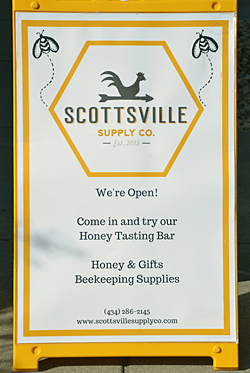 After Coleman's closed for business, the building's downstairs remained vacant for a while. When negotiations were completed
with a prospective new tenant and a great deal of interior renovation was completed, the Scottsville Supply Company, a business that
serves those interested in beekeeping and a source for associated supplies and equipment related to beekeeping, relocated from their
location on Valley Street to the Masonic Building occupying the vacant first floor. After Coleman's closed for business, the building's downstairs remained vacant for a while. When negotiations were completed
with a prospective new tenant and a great deal of interior renovation was completed, the Scottsville Supply Company, a business that
serves those interested in beekeeping and a source for associated supplies and equipment related to beekeeping, relocated from their
location on Valley Street to the Masonic Building occupying the vacant first floor. In June of 2019, Dimitri Hasson and Lucas RVP V, LLC, having purchased property on East Main Street, the former bus depot, another Scottsville site of historic importance, appeared before town council with a proposal. They would remodel and improve the structure, and it would become a mixed use development that would consist of rental and retail. The town approved the request, and work is currently ongoing. As with any aging structure, maintenance issues continue to be both unavoidable and costly. When you have a building over a hundred years old this is an inevitable fact. And, with fewer people joining civic and service , revenue that can be used for maintenance is hard to find. Hasson and Lucas have basically "come to the rescue" and purchased the building. A hundred year old building having only its second owner is most likely a real estate oddity. Brian Lafontaine, a member of Lodge 45, while not going into details, said the arrangement was "really in the best interest of everyone involved." The first floor tenant will continue to occupy that space, and Lodge 45 will continue to have their space on the second floor. 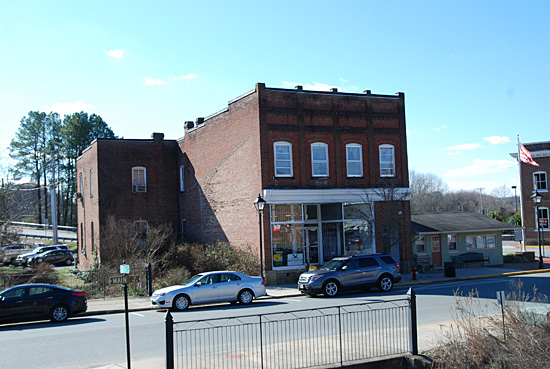 Scottsville Masonic Lodge No. 45 (top floor) and Scottsville Supply Co. (first floor) in 2020. The next time you stroll down Valley Street or Main Street or you pass one of Scottsville's historic residences, with a little imagination you might visualize one of the Jeffersons, Teddy Roosevelt, or some other historical figure going in or coming out of one of the buildings you are passing. The Masonic Building has seen a lot. And, with a new lease on life is sure to see much more! In the February 21, 2020, edition of the Scottsville Monthly, Ron Smith authored the following article about the current status of this Masonic Lodge building in 2020: Scottsville's Masonic Building Sold! By Ron Smith, Correspondent The cornerstone reads 1914. The building's architecture is similar to many buildings from that time period found around the country. This Scottsville building has been the meeting place of Scottsville Masonic Lodge No. 45 since its construction. And, it's only the third location the lodge has called home since being chartered by the Grand Lodge of Virginia on December 17, 1851. The Beal Building at the corner of Valley and Bird Streets was the social hub of Scottsville in the town's early days. It was large enough to accommodate a sizeable number of persons for meeting, a dance, or some other social event. Being referred to as Beals' Hall, the Lodge met regularly on the second floor. In 1880, Lodge No. 45 moved to a private residence on Valley Street and actually purchaseded the second floor of that structure. In a 2005 Scottsville Monthly article by Ruth Klippstein, Scottsville's former mayor, Raymon Thacker, related how his family "lived on the first floor of this home when they first moved to Scottsville before moving to a home of their own. In 1913, the home on Valley Street would become the residence of noted Scottsville physician, Dr. Luther Randolph Stinson. In 1914, Lodge No. 45 purchased a parcel of land on Main Street for $250 dollars. With a loan from the town of $4,000, the Lodge was into what was expected to be a $6,000 project. On June 17, 1914, the cornerstone was laid after a parade and speeches by Masonic dignitaries including a past Grand Master of the Lodge of Virginia. D. Wiley Anderson was a well-known architect. He had been responsible for a number of large projects in Richmond and had relocated to Scottsville in 1913. While it is not known for sure who the architect for the project was, it is suspected that it was Anderson. What is known for sure is that the contractor for the project was the Scottsville firm of Paulett and Grove. Anderson would later design Scottsville's Victory Hall. The National Register of Historic Places describes the building as "Modified Edwardian" based on the pattern in which the bricks are laid, the flat roof, and the window placement. Metal ceiling tiles had become popular in 1885, and this building incorporated them as it was a more economical way to replicate pricier plaster designs then favored in European architecture. The building has survived a number of floods caused by Hurricane Camille in 1969 and Agnes in 1972. The hurricanes wreaked a lot of damage to the town, and some to the building. There have been some structural changes over the years mostly in areas not seen by the public. The Masonic Lodge has continued to occupy the second floor while the first floor has seen three different occupants. After completion of the building, the Scottsville Post Office, under the guidance of Postmaster Sam Gault, occupied the first floor until a new post office was built and opened in 1964. Coleman's, an establishment offering hunting, fishing, and other outdoor related merchandise and services, followed the post office as a tenant until that business closed a few years ago. Now the space is occupied by the Scottsville Supply Company which offers beekeeping supplies, information, and instruction. In the 2005 article, Thacker stated, "We used the rental income not for profit, but to help with the routine maintenance of the building." Like a lot of organizations, the Masonic Order has seen a decline in membership. Members get older, and due to health issues or death, membership declines. And many younger individuals do not have either the time or the interest in becoming a part of a service or fraternal organization. Buildings get older, and maintenance costs increase. And with older buildings, maintenance issues arise more frequently. Last year, Lucas RVP V. LLC and Dimitri Hasson purchased the property on East Main Street that had once been the Scottsville Bus Company. Plans for that property include mixed use, rental, business, retail, and a restaurant. The Town of Scottsville approved the plans, and work is currently progressing on the site. This company has now made it possible for Masonic Lodge No. 45 to keep their home so to speak as they have worked out an agreement with the Lodge and purchased the Masonic Building. According to Lodge member, Brian LaFontaine, it was "a deal that really made us (the Lodge) happy. We will be able under the agreement to continue to use the upstairs as our meeting place for the foreseeable future." One of the great things about Scottsville is its history. Not just the fact that many notables walked the streets, came through town, or lived here. It is the historical significance of the buildings we see every day. Next time you walk down Valley Street or through an adjacent neighborhood, just look around and think about what or who was there before you. On January 25, 2021, Evelyn Edson, President of Scottsville Museum, sent the following history email to our readers: The Masons Are Moving! By Evelyn Edson The Scottsville Lodge of the Ancient, Free and Accepted Masons has sold its building on Main Street and is moving its meetings to the Taylor Masonic Lodge in Centenary, VA. With only thirty members left in Scottsville, maintaining the building became just too costly. We joined Brian LaFontaine last week as he was cleaning out over a hundred years of documents, furniture, and pictures and contents of a large antique safe. Freemasonry has its roots in the stonemasons' guilds of the Middle Ages. In the 18th century, it developed an interesting life of its own, dedicated to Enlightenment ideals such as liberty, equality, religious toleration, and thirst for knowledge. The first Masonic Lodge was opened in America in the 1730s, and in 1755 the young George Washington joined the order. Because of its secret rituals, the Masonic order became a target for conspiracy theories. During the French revolution, the Masons were thought to be plotting the downfall of the monarchy, and in America, they were suspect for their revolutionary views. In 1828, a short-lived Anti-Masonic Party was organized to combat a supposed conspiracy. 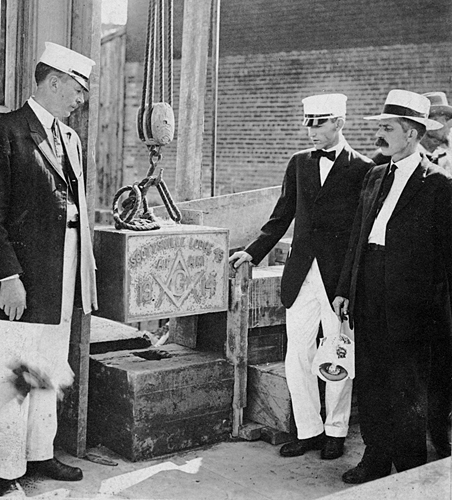 William F. Paulette (right) stands with two Masons as they prepare to install the cornerstone of the Scottsville Lodge #45 on June 17, 1914. The first Scottsville lodge was established in 1851, and over the years many prominent citizens (mayors, ministers, and businessmen) have been members, including Sam Gault, Raymon Thacker, C.R. Dorrier, T.E. Bruce, Thomas Staples Martin, and Dr. Ruebin Stinson. The Lodge met in several places in town, and finally laid the cornerstone of its own building in 1914. The Masons met upstairs, and the street floor was rented to the Post Office. In 1951, the Lodge celebrated its 100th anniversary, "A Century of Faith, Hope, and Charity." 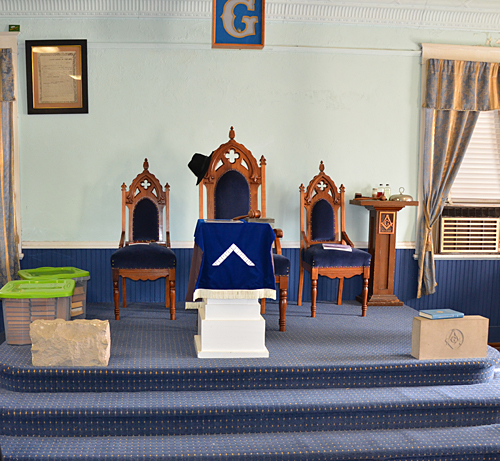 Above is the Scottsville Lodge 45 dais on the upper floor of the building. At the left of the dais is an unpolished ashlar stone, and at the right is a polished stone. Brian showed us two stones on either side on the dais: one a roughcut ashlar and the other a polished stone with the masonic emblem on it; see above photo. They represent, he said, the rough cut of a new member and his polished state after years of membership. Membership is for men only, but there is an auxiliary order for women, the Daughters of the Eastern Star. Prince Hall, a Masonic Lodge for African-American men, was established in Boston in 1784 as the lodges were then segregated, but local chapters are now open to men of all races. The Shriners, an upper level of the Masonic order, we know from their zipping around in little cars at Scottsville parades, have established and maintain children's hospitals throughout the U.S. Local honey-lovers will be pleased to hear that Taylor Schmidt, the purchaser of the Masonic building, intends to continue the lease of Scottsville Supply (the 'Bee Store') on the ground floor. References: Top Image Located On: Capturing Our Heritage, CDB28 B421cdB28.tif B421cdB28.jpg B421cdB28.psd Second Image Located On: Capturing Our Heritage, CDCG08 CG89cdCG08.tif CG89cdCG08.jpg CG89cdCG08.psd Third Image Located On: Capturing Our Heritage, CDRA01 RA01cdRA01.tif RA01cdRA01.jpg RA01cdRA01.psd Fourth Image Located On: Capturing Our Heritage, CDB12 B01cdB12.tif B01cdB12.jpg B01cdB12.psd Fifth Image Located On: Capturing Our Heritage, CDCG2020 CG064cdCG2020.tif CG064cdCG2020.jpg CG064cdCG2020.psd Sixth Image Located On: Capturing Our Heritage, CDRS2020 RS063cdRS2020.tif RS063cdRS2020.jpg RS063cdRS2020.psd Seventh Image Located On: Capturing Our Heritage, CDRA04 RA23cdRA04.tif RA23cdRA04.jpg RA23cdRA04.psd Eighth Image Located On: Capturing Our Heritage, CDCG2021 CG01CG2021.tif CG01CG2021.jpg CG01CG2021.psd |
|
|
|
Museum
Archive
Business
Cemeteries
Church
Events
Floods
For Kids
Homes
Portraits
Postcards
School
Transportation
Civil War WWII Esmont Search Policy |
||||
|
Scottsville Museum · 290 Main Street · Scottsville, Virginia 24590 · 434-286-2247 www.avenue.org/smuseum · info@scottsvillemuseum.com Copyright © 2020 by Scottsville Museum |
||||